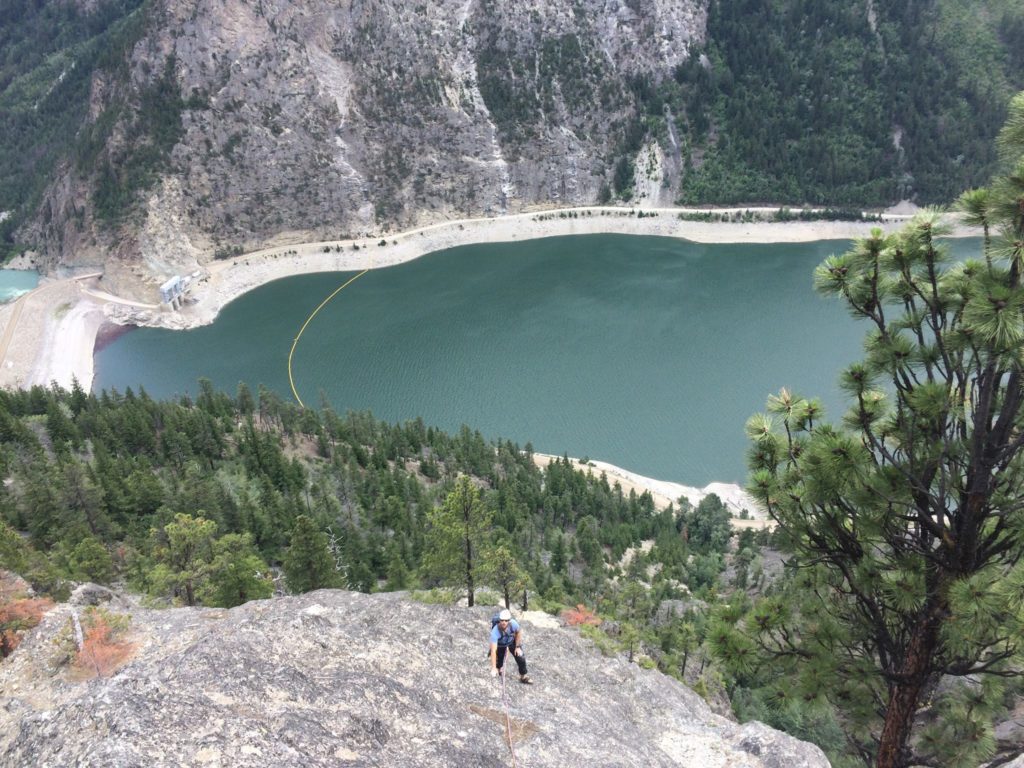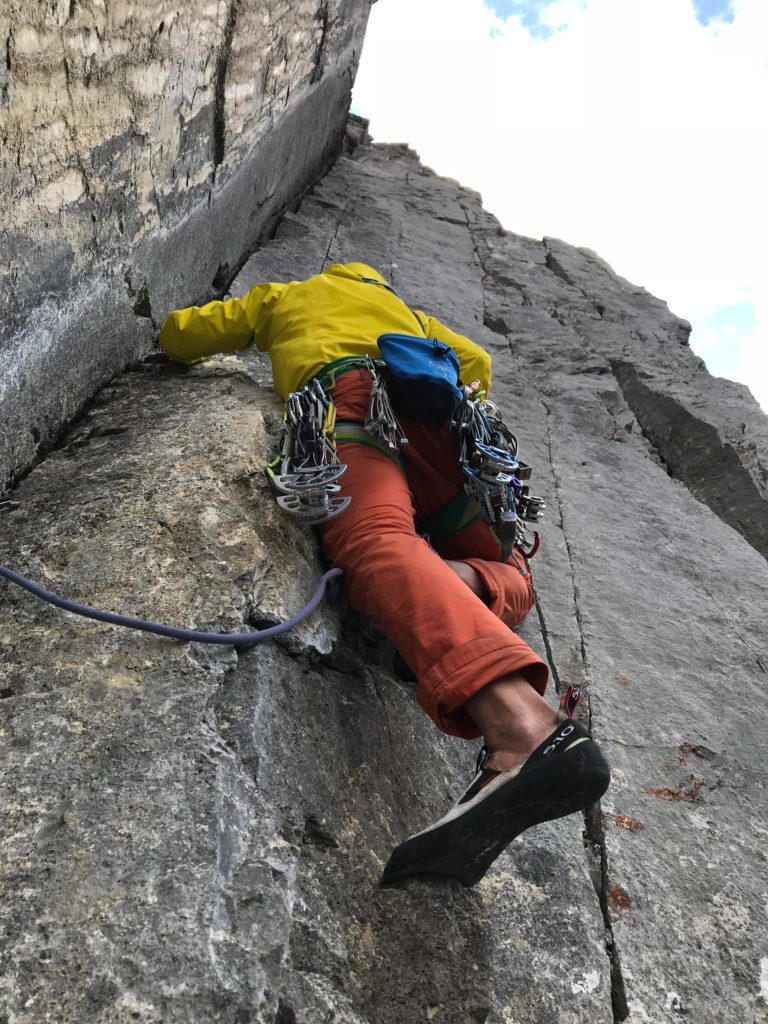The Stories Behind Some of My Route Names
Nearly every climbing route name has a story behind it

Route names are important and they’re an opportunity to tell a story, remember someone or be creative. As climbing becomes more popular and more people will be referring to route names, it’s important for climbers who name routes to be mindful of the title they attach to it. Our goal as route developers is to create an inclusive experience for those who follow. I’ve been establishing new routes across Canada for 20 years, some are short and bolted, some are trad multi-pitches and some are 30-pitch alpine lines, and they all have names.
The first route I named was Sunnyside Up, a 5.7 sport climb at Silver Harbour in Thunder Bay. It climbs a frying pan feature up the only real slabby rock at the crag, which means it soaks up the sun. The now-gone Thunder Bay Restaurant made amazing sunnyside up eggs, which my partners and I would order before heading to the crag.
I named dozens of routes in Thunder Bay while attending university there, including Wit of a Ninja 5.12 (because the crux requires a witty dynamic move), Hazy Waves 5.10 (because the arete it climbs makes you feel dizy), Copper’s Breakfast 5.7 (because the route is a bit of a dog’s breakfast and my partner’s dog’s name was Copper), The Wrangler 5.12 (because we drove a Jeep Wrangler to the crag that day), The Next Generation M9 (because it was the first of the grade in the area), Return to Sender 5.11 (because it took a number of trips to climb it and Timmy O’Neil had a film come out that year with the same name), Building an Ego 5.11 (because it was the first of the grade I established), and Dark Dog 5.8 (because my partner Derrik Patola and I were drinking an energy drink with the same name).
In 2005, my climbing partner Will Meinen and I had moved to the Canadian Rockies after graduation, but returned to Thunder Bay mid-winter because we heard some unclimbed ice had formed on Mount McCrae above the city. We drove straight from Canmore in a 30-hour push through winter storms and parked at the base of the wall. Local climbers were making plans to make the first ascent of the route that day, but Meinen and I skunked them and called the 80-metre WI5+ The Boys are Back in Town. Not to be outdone, local Nick Buda climbed the smear to the right and called it The Men Never Left WI5+ and climbing legend Scott Backes climbed the smear farther to the right and called it Young at Heart WI5+. Backes had recently gone through a triple heart bypass.
Back in the Rockies, Meinen and I focused on a new mixed crag in Evan Thomas Creek, where we established a number of bolted ice/rock routes. We called it the wall Rehab Wall because Meinen was recovering from a broken ankle and the long walk was a good workout. The most proud line is Physiotherapy, a fun M7 up solid rock with horizontal features. Pulling onto the ice was good physio for Meinen’s recovery. Soon after that, Meinen and I made the first ascent of the massive southeast ridge of Mount Kidd and called it Tah-Osa Ridge. Mount Kidd was named after Stuart Kidd, a trading post manager in the town of Morley, who was made an honourary chief of the Stoney. His Stoney name was Tah-Osa, which means moose killer.
The following winter, Meinen and I got to work on a big mixed route on Pigeon Mountain in the Bow Valley. There were a few pitches of steeped mixed to a hanging curtain of ice. The approach took a few hours, so we set up camp and worked on the route for the next few winters, Eventually we called in Will Gadd to help us finish it because the climbing was too difficult. Gadd freed it at M11 WI5+ and we called it The Jimmy Skid Rig, because the power drill we used was named Jimmy.
On Vancouver Island, I spent a few weeks bolting routes at Sutton Pass, the closest crag to Tofino, and named a short slab Sea Flea 5.9. The name comes from Chris Weldon’s boat Sea Flea, which we used to boat across the Howe Sound to climb on the big granite walls on the opposite shore of Squamish. North of Squamish, Danny O’Farrell and I climbed the first major rock route in the Bridge River Canyon and called it Bridge River Buttress, a 1,000-metre 5.7 granite route. It climbs above the Terzaghi Dam, which is named for Karl von Terzaghi, who founded the science of soil mechanics, and the crux pitch on the route is the Terzaghi Traverse.
On Mount Athabasca, Darren Vonk and I spied a line on the close-to-the-road west buttress, which we climbed in six pitches at M5. We named it The McKibbin after our friend Neils McKibbin, who died in a crevasse fall on Mount Hector earlier that year. And on Goat Mountain near Yamnuska, Vonk and I made the first ascent of Riff Raph Ridge, in hounour of our friend Raph Gagne who took his own life a few days before we climbed it.

On Ha Ling Peak near Canmore, I established an 11-pitch climb up the western slabs between the north face and hiker’s trail through the forest. The long 5.9 is called Soft Moth, because the most difficult and unrepeated route in the valley is Iron Butterfly, a route I’ll likely never attempt, but I will run laps up Soft Moth. Across from it is Kanga Crag, where a 100-metre slab rises above the upper Grassi Lakes parking area, the same spot where you park for True Grit. I bolted three routes with varying partners, including Godzilla 5.9, Hot Fuzz 5.8 and Sharknado 5.8. All three are named after fun Hollywood movies that are not to be taken too seriously, much like these routes.
Sonnie Trotter invited me to help establish a four-pitch route on the tier of rock below his Castles in the Sky, a six-pitch 5.14, to create a direct line from the forest. The first pitch had rock that was some of the worst on the mountain either of us had climbed, but it improved higher up. In the end, the steep bolted route went at 5.11+ and we called it The Moat because it is one of the lowest routes on Castle Mountain.
On Tunnel Mountain’s south end, a wall that takes only five minutes to access from the road, are a number of classic routes, like The Shoe 5.8. Last year, Matt Westlake and I climbed a long 5.7 up the obvious buttress that separates the east and south faces and called it Buffalohorn. The route opposite is the classic Rundlehorn and the mountain was once called Sleeping Buffalo, so Buffalohorn just made sense. Farther south on the wall is Dancing Sasquatch, a route that took 25 hours to clean, but resulted in a fun 5.5-ish three-pitch climb that is close to the car. To the right of that is The Dirtbag, a four-pitch 5.10a that is fully bolted and almost clean enough to share the beta to.
In the bowl behind EEOR, the large wall above Canmore on Mount Rundle, I established a three-pitch 5.10 trad-mixed route that follows one of the best cracks in the Bow Valley. I called it The Halfpipe in memory of Marc-Andre Leclerc’s big wall linkup of the north face of Ha Ling and the east face of EEOR. In total he soloed over 1,000 metres up to 5.10+ and ran between the walls in just over three hours, a mind-boggling feat of climbing and endurance which he called the Canmore Halfpipe. I climbed it with Adam Campbell, shortly after we made the first ascent of Homage to the Warden, a 300-metre 5.6 alpine-style ridge we named in memory of Tim Auger, one of the most influential climbers and park wardens ever in Canada. He made the first ascent of Homage to the Spider in the later 1980s on Mount Louis.

Earlier this year, I climbed a crack off the road in the small northern Ontario town of Webbwood with Alyssa Acchione on a long drive from Toronto to Canmore. The 25-metre trad route is the only climb on the small cliff. We named it Barb’s Town after Barbara McCallum Hanley, the mayor of Webbwood from 1936 to 1944, she was the first woman in Canadian history to be elected as a mayor in a general election.
This past winter, Joey Wallick and I decided to take a look at the terrain above my 2006 ice route Ghoster Coaster in Cougar Creek near Canmore. I named it Ghoster Coaster after the roller coaster at Canada’s Wonderland, a ride that my grandmother first took me on, because the canyon the route flows down reminds my of a roller coaster. We continued climbing to the upper wall and up an obvious ridge to the summit of a small peak north of Mount Lady Macdonald. We topped out at midnight in freezing cold winter weather in early January. I called the climb Agnes Ridge III M4 after Lady Agnes Macdonald, the second wife of Canada’s first prime minister, Sir John A. Macdonald.
Over the past few months, I’ve spent time establishing bolted multi-pitch climbs in the Bow Valley, but took a short break to climb a new five-pitch 5.10 trad route on the Rimwall with Cory Rogans, which we named The Hobbit. The first ascent of the Rimwall was by George Homer and Jon Jones in 1972, two climbers of the generation who named many local routes after Lord of the Rings references.
The first multi-pitch bolted route of the year was Minihapa, a four-pitch 5.5 next to the lowest section of Cascade Falls near Banff. I named it after the Stoney First Nation word for the peak, which was Minihapa. Above Minihapa, local mountain guide Joe McKay bolted a four-pitch 5.6 addition that he called Back to Batoche, named after the yearly celebration hosted by The Métis Nation in Saskatchewan at the historic site of The Battle of Batoche. On Mount Rundle, I teamed up with Dave Smart to establish the eight-pitch fully bolted MacLab Slab 5.6. The route starts about 100 metres right of Rundlehorn and is named after the MacLab pub at the Banff Centre, where climbers meet to talk about their day out on the rock.
Smart and I also completed a new 15-pitch bolted 5.7, one of the longest at the grade in Canada that is fully equipped. We named it Gold Rush, mostly because there is a band of yellow rock you’re hurrying to reach before traversing to better stone, but also because of the history of the area. The nearby Johnston Canyon was named after a gold seeking prospector named Johnston, who never found any gold but spent a summer looking in the area west of Banff. After that summer, Silver City, a gold and silver mining town, sprang up at the base of Castle Mountain with a population near 3,000 (bigger than Calgary at the time), but was a ghost town 15 years later after no silver or gold was found. The route is currently being cleaned for others to enjoy.
Nearly every route name has a story that’s worth knowing, but not every guidebook or article tells that story. If you have a story about why you named a route what you did, send me an email at brandon@gripped.com and we’ll be sure to share it with others.


